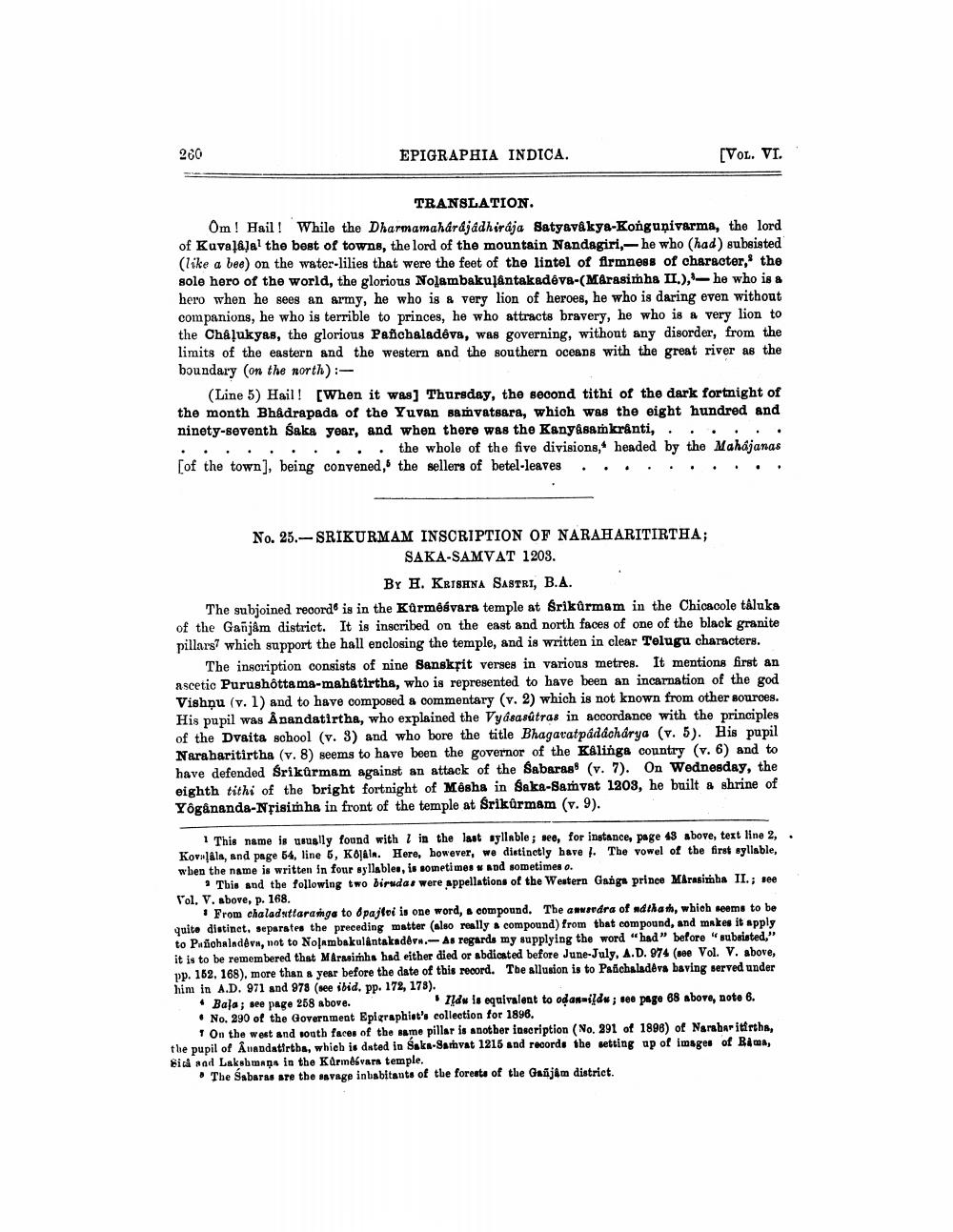________________
260
EPIGRAPHIA INDICA.
[VOL. VI.
TRANSLATION Om! Hail! While the Dharmamaharajadhiraja Satyavákya-Kongunivarma, the lord of Kavala)al the best of towns, the lord of the mountain Nandagiri,- he who (had) subsisted (like a bee) on the water-lilies that were the feet of the lintel of firmness of character, the sole hero of the world, the glorious Nolambakufântakadēva-(MArasimha II.), - he who is a hero when he sees an army, he who is & very lion of heroes, he who is daring even without companions, he who is terrible to princes, he who attracts bravery, he who is a very lion to the Châļukyas, the glorious Pañchaladéve, was governing, without any disorder, from the limits of the eastern and the western and the southern oceans with the great river as the boundary on the north)
(Line 5) Hail! [When it was] Thursday, the second tithi of the dark fortnight of the month Bhadrapada of the Yuvan samvatsara, which was the eight hundred and ninety-seventh Saka year, and when there was the Kanyasamkranti,.... . . . . . . . . . . the whole of the five divisions, headed by the Mahajanas [of the town), being convened, the sellers of betel-leaves .
.
No. 25.-SRIKURMAM INSCRIPTION OF NARAHARITIRTHA;
SAKA-SAMVAT 1203.
BY H. Krishna SASTRI, B.A. The subjoined record is in the Kurmêsvara temple at Srikurmam in the Chicacole täluka of the Ganjam district. It is inscribed on the east and north faces of one of the black granite pillars7 which support the hall enclosing the temple, and is written in clear Telugu characters.
The inscription consists of nine Sanskřit verses in various metres. It mentions first an ascetic Purushottama-mah&tirtha, who is represented to have been an incarnation of the god Vishnu (v. 1) and to have composed a commentary (v. 2) which is not known from other sources. His pupil was Anandatirtha, who explained the Vyasasútras in accordance with the principles of the Dvaita school (v. 3) and who bore the title Bhagaratpádácharya (v. 5). His pupil Narabaritirtha (v. 8) seems to have been the governor of the Kalinga country (v. 6) and to have defended Srikûrmam against an attack of the Sabaras (v. 7). On Wednesday, the eighth tithi of the bright fortnight of Mêsha in Saka-Samvat 1208, he built a shrine of Yogananda-Nrisimha in front of the temple at Srikürmam (v. 9).
This name is usually found with 1 in the last syllable; see, for instance, page 43 above, text line 2,. Kovaļâls, and page 54, line 6, KO]. Here, however, we distinctly have . The vowel of the first syllable, when the name is written in four syllables, is sometimes w and sometimes o.
This and the following two biruda, were appellations of the Western Ganga prince Marasimha II.; 100 Vol. V. above, p. 168.
From chaladattaranga to 6pajtoi is one word, s compound. The anus dra of nathan, which seems to be quite distinct, separates the preceding matter (also really a compound) from that compound, and makes it apply to Patohaladva, not to Nolambakulántakadors.-As regards my supplying the word "had before subsisted," it is to be remembered that Marmoimhe had either died or abdicated before June-July, A.D. 974 (see Vol. V. above, pp. 162, 168), more than a year before the date of this record. The allusion is to Pachaladeva baving served under him in A.D. 971 and 978 (see ibid. pp. 172, 178). • Bala; see page 268 above.
Ilds is equivalent to odani du; to page 68 above, note 6. • No. 290 of the Government Epigraphist's collection for 1896.
1 On the west and south faces of the same pillar is another inscription (No. 391 of 1898) of Narabar itirths, the pupil of Anandatirtba, which is dated in Saka-Samvat 1215 and records the setting up of images of Bima, Bitá nad Laksmams in the Karmsvara temple.
The Sabaras are the savage inhabitants of the forests of the Guajam district.




